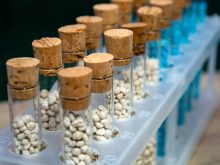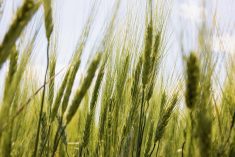
Eric is a prosperous grower with a 10,000-acre grain farm near Verwood, Sask., which produces durum wheat, canola, chickpeas and lentils. In early June, he’d been out scouting his durum field for herbicide timing when he saw something that suggested he had a disease problem on his hands. It appeared some kind of leaf disease had infested the durum and Eric feared the whole crop was in jeopardy.
“I’m losing my crop to leaf disease, and it’s only at the three-leaf stage,” Eric told me over the phone. “I need you to come take a look and tell me what fungicide I need to spray to save my crop!”
When I arrived at Eric’s farm and walked through the field, I observed a seemingly even durum stand, with numerous plants exhibiting chlorotic and necrotic lesions on their leaves. The affected durum wasn’t evenly distributed throughout the field but appeared in patches that had no discernable pattern.
Read Also

Claas brings 1000 Series SP forage harvesters to Canada
In mid-August, Claas unveiled its new line of Jaguar forage harvesters at an event in Visalia, California, deep in the heart of that state’s dairy region.
When I pulled out some of the symptomatic plants to have a closer look, I could see they had poor root development and were somewhat stunted both above and below ground compared with the rest of the crop. I also observed the soil around them was lighter in texture with not much in the way of organic matter.
Although the plant symptoms resembled that of fungal leaf disease such as septoria leaf blotch or tan spot, I was somewhat perplexed. In my experience, I had never seen a leaf disease develop this severely in durum as early as the three-leaf stage before, and environmental conditions hadn’t been particularly conducive for disease development, either.
To rule out whether there might be a disease issue due to poor crop rotation or infected seed, I asked Eric about the field’s history. I learned he’d used certified seed when planting the durum, which was seeded on canola stubble. Eric also informed me there hadn’t been a cereal grown on the field for the past two years.
I began considering alternative explanations for the durum symptoms as well, such as the possibility of herbicide damage or carryover. Eric told me he’d done a pre-seed burn-off with glyphosate mixed with a Group 2 herbicide, and that no residual chemistries had been applied in the field in the two previous years.
I thought of nutrient deficiency as another possibility. When I asked Eric about his fertility program, I was told 60 pounds of 11-52-0 monoammonium phosphate fertilizer had been seed placed in the field and another 210 pounds of urea fertilizer had been placed mid-row.
At this point, nothing was leaping out at me as the most likely explanation for the sickly-looking durum plants. In the hope plant tissue and pathology testing might reveal the answer, Eric and I collected a few samples of the symptomatic plants and sent them off for lab analysis.
Crop Advisor Solution: Zinc deficiency responsible for symptoms in durum field
While gathering the samples, I noticed the plants were somewhat stunted and had poor root development. This, coupled with the fact the symptomatic durum was growing in soil that was lightly textured and contained little organic matter, suggested nutrient mobilization could be an issue. For this reason, I decided to collect some plant tissue samples to send off for laboratory analysis as well.
The pathology test results came back first and confirmed there was no detectable leaf disease pathogen present. It was clear, then, the plant symptoms were a result of a nutrient deficiency, but the question was which one? We found out once the tissue tests came back showing a deficiency in zinc.
The symptomology was characteristic of this nutrient deficiency, and given the soil characteristics and conditions, it all made sense — especially considering Eric’s fertility program didn’t include any zinc products.
Fortunately for Eric, this was a situation he could take steps to correct. He was able to reduce the yield impact on his durum crop with a foliar zinc application. Going forward, Eric plans to incorporate zinc into his fertility program as a long-term solution to the problem.
Foliar nutrition is an effective practice for applying nutrients to the crop; however, it is often used in rescue-treatment scenarios such as this. Zinc is immobile in the soil, which means growers can build up zinc with soil-applied products while keeping the application more cost-effective. Crop yields can be reduced by 20 per cent before there are visual symptoms, so utilizing soil and tissue tests prior to in-field symptoms can help manage severe zinc deficiencies before they occur.















